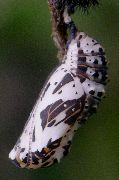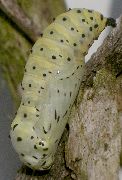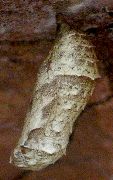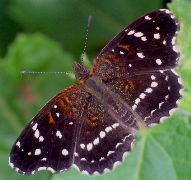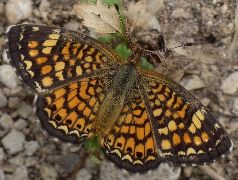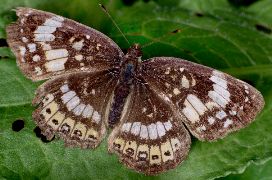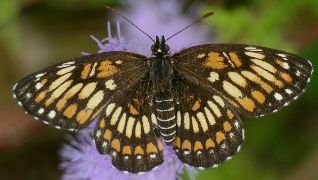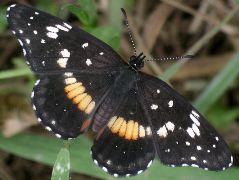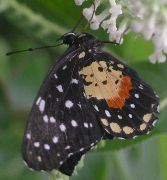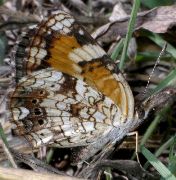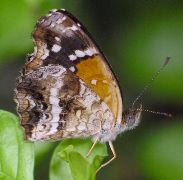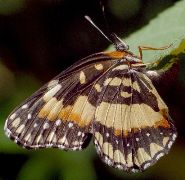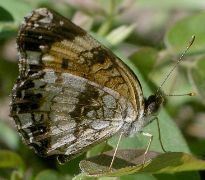
| Nymphalidae ~ Brush-footed Butterflies |
page 1 ![]() page 2
page 2 ![]() page 3
page 3 ![]() page 4
page 4 ![]() page 5
page 5
|
The chrysalises of patches and crescents are rather small and rounded in appearance. They have varied markings but tend to be lighter colored when they are fresh and turn darker as they mature. The pupae are usually in sheltered areas, but may also be right out on branches. Illustrated below are the chrysalises of the Bordered Patch, Crimson Patch, and Phaon Crescent.
The four crescent species in our area are small with varying patterns of dots and checker marks. They frequently rest with their wings open, so the tops are easily visible, and also tend to stay close to the ground or in low vegetation. The most distinctive is the Texan Crescent (Phyciodes texana), which is also one of the most common. The tops of the wings are quite dark and can sometimes appear to be mostly black. The top of the thorax sometimes reflects a dark metallic greenish blue. Within the dark background of the wings are reddish and white spots. The forewings also have a distinct notch in their outer edge. It is lined with white, especially visible in fresh individuals.
The Phaon Crescent (Phyciodes phaon) has orange and yellow mixed in with the dark markings on its wings. The most distinguishing feature for this species is the white band of spots in the middle of each forewing. It always contrasts sharply with the orange of other spots on the wings.
The Pearl Crescent (Phyciodes tharos) is another very common species. It is mostly orange and has large black patches on the forewings. However, these can vary considerably so it takes a bit of practice to recognize worn or unusual individuals.
The least common of our crescents is the Vesta Crescent (Phyciodes vesta). This is another variable species, but tends to look more evenly checkered than the Pearl. One slightly misleading feature is that females sometimes have lighter spots in the middle of their forewings, similar to those on Phaon Crescents. However, these are never as strongly white as that species and there are other differences in the markings too. I've only seen the Silvery Checkerspot (Chlosyne nycteis) occasionally. It is a dark butterfly with gold and orange markings. The photo shown here is a very worn individual, so the yellow has faded to white and the orange to light yellow. The best clue to identification are the open circles with white centers on the hind wings.
The Theona Checkerspot (Thessalia theona) is not particularly common and only shows up once in awhile. It has yellow and orange markings but they tend to be longer in shape and not so "checkered" as similar butterflies.
The Bordered Patch (Chlosyne lacinia) is usually abundant in this area. They are easy to photograph because they often feed at flowers, moving slowly about with their wings spread open. Their markings are highly variable, especially the extent of the yellow/orange bands that cross both front and hind wings. Although their base color is usually black, it can also be a dark brown.
The other patch, which has very recently expanded its mostly southern range to include our area, is the Crimson Patch (Chlosyne janais). This striking butterfly is mostly black with white dots on the forewings. The hind wings have large orange-red patches so identification is quite easy. The undersides of the wings on crescents and patches are often quite different from the tops. The butterflies sometimes rest with their wings folded up over bodies, so it is helpful to also know what the markings for this part of the wings. In fact, the crescent mark that gives those butterflies their common name is only seen on the underside of the lower wing. It is a small white mark near the outer edge of the wing, surrounded by darker color which sets it off. Because of the complexity of the markings on the wings in general, this tiny feature is easily overlooked. The next three photos show the crescent on the Pearl, Phaon, and Texan.
The patches have more distinctive undersides to their wings, and are not easily confused with the crescents or checkerspots. However, the mix of orange, white and black found on these other species makes for quite an identification challenge. While the Bordered Patch shown above is pretty easy to identify, the Silvery Checkerspot is very similar to the crescents. |
page 1 ![]() page 2
page 2 ![]() page 3
page 3 ![]() page 4
page 4 ![]() page 5
page 5
![]()
